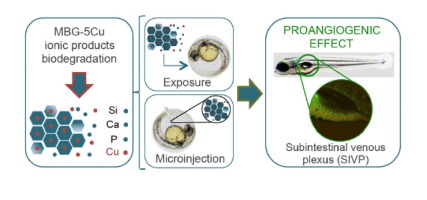Acta Biomaterialia ( IF 9.4 ) Pub Date : 2017-12-27 , DOI: 10.1016/j.actbio.2017.12.032 Lilian B. Romero-Sánchez , Manuel Marí-Beffa , Paloma Carrillo , Miguel Ángel Medina , Aránzazu Díaz-Cuenca

|
The osteogenic and angiogenic responses of organisms to the ionic products of degradation of bioactive glasses (BGs) are being intensively investigated. The promotion of angiogenesis by copper (Cu) has been known for more than three decades. This element can be incorporated to delivery carriers, such as BGs, and the materials used in biological assays. In this work, Cu-containing mesoporous bioactive glass (MBG) in the SiO2-CaO-P2O5 compositional system was prepared incorporating 5% mol Cu (MBG-5Cu) by replacement of the corresponding amount of Ca. The biological effects of the ionic products of MBG biodegradation were evaluated on a well-known endothelial cell line, the bovine aorta endothelial cells (BAEC), as well as in an in vivo zebrafish (Danio rerio) embryo assay. The results suggest that ionic products of both MBG (Cu free) and MBG-5Cu materials promote angiogenesis. In vitro cell cultures show that the ionic dissolution products of these materials are not toxic and promote BAEC viability and migration. In addition, the in vivo assay indicates that both exposition and microinjection of zebrafish embryos with Cu free MBG material increase vessel number and thickness of the subintestinal venous plexus (SIVP), whereas assays using MBG-5Cu enhance this effect.
Statement of Significance
Mesoporous bioactive glasses (MBGs) with high specific surface area, well-ordered pores, large pore volumes and controllable amount of ions are interesting to develop controlled drug delivery systems for bone tissue regeneration. Copper (Cu) incorporation to the basic SiO2-CaO-P2O5 composition has attracted high interest due to its multifunctional biological properties. Promotion of angiogenesis is one of these properties, which can be integrated to the biomaterial with lower cost and higher stability when compared with growth factors.
This work reports the synthesis and characterization of Cu-containing MBG evaluating its angiogenic properties in the subintestinal vessel zebrafish assay. This transgenic in vivo assay is merging as an alternative model providing short-time consuming protocols and facilities during pro-angiogenic drug screenings. The report shows that the ionic products of this MBG material delivered to the zebrafish incubation media significantly enhance angiogenesis in comparison with control groups. Besides, results indicate Cu ions may exhibit a synergic effect with Si, Ca, and P ions in angiogenesis stimulation both in vitro and in vivo. To our knowledge, this is the first time that zebrafish in vivo assays are used to evaluate angiogenic activity of ionic dissolution products from MBG materials.
中文翻译:

含铜的介孔生物活性玻璃在体内斑马鱼模型中促进血管生成
人们正在深入研究生物对生物活性玻璃(BGs)降解的离子产物的成骨和血管生成反应。铜(Cu)促进血管生成已有三十多年的历史了。可以将该元素掺入递送载体(例如BG)中,以及生物测定中使用的材料中。在这项工作中,制备了SiO 2 -CaO-P 2 O 5组成系统中的含Cu介孔生物活性玻璃(MBG),通过取代相应量的Ca来掺入5%mol的Cu(MBG-5Cu)。在著名的内皮细胞系,牛主动脉内皮细胞(BAEC)以及体内,评估了MBG生物降解离子产物的生物学效应。斑马鱼(Danio rerio)胚胎测定。结果表明,MBG(不含铜)和MBG-5Cu材料的离子产物均能促进血管生成。体外细胞培养表明,这些物质的离子溶解产物无毒,可促进BAEC的活力和迁移。此外,体内试验表明,斑马鱼胚胎的暴露和显微注射均采用无铜MBG材料可增加血管数目和肠下静脉丛(SIVP)的厚度,而使用MBG-5Cu的试验可增强这种效果。
重要声明
具有高比表面积,有序的孔,大的孔体积和可控制的离子含量的中孔生物活性玻璃(MBG)对于开发用于骨组织再生的可控药物递送系统非常有趣。掺入基本SiO 2 -CaO-P 2 O 5组合物中的铜(Cu)由于其多功能的生物学特性而引起了人们的极大兴趣。促进血管生成是这些特性之一,当与生长因子相比时,可以以更低的成本和更高的稳定性整合到生物材料中。
这项工作报告了含铜的MBG的合成和表征,以评估其在肠下血管斑马鱼测定中的血管生成特性。这种转基因体内测定法正在融合为一种替代模型,在促血管生成药物筛选期间提供了耗时短的方案和设施。该报告显示,与对照组相比,传递到斑马鱼培养液中的这种MBG材料的离子产物显着增强了血管生成。此外,结果表明Cu离子在体外和体内均可在血管生成刺激中与Si,Ca和P离子表现出协同作用。据我们所知,这是斑马鱼首次在体内 测定法用于评估来自MBG材料的离子溶解产物的血管生成活性。











































 京公网安备 11010802027423号
京公网安备 11010802027423号